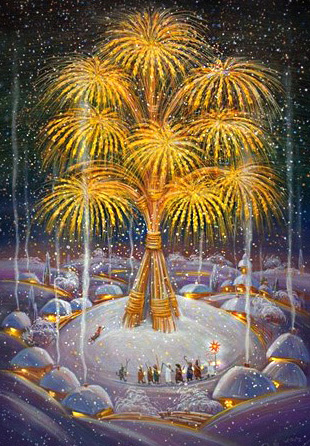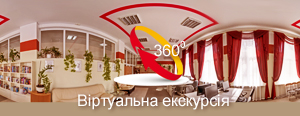Christmas Spirit by Oleh Shupliak// https://shupliak.art/uk/gallery/2017/christmas- grandfather
It is as if the pure birds go into the warmer climates, the blessed souls fly away into the Better Land.
Their ways are spread by the magnetic fields where Didukhs unite the World and the Better Land.
Every one of us has the own magnet and everyone is that what it attracts.
That is the way how the memory of the ancestry is attracted by Did,
while the Spirit of Eternity hides the World of Stars in bunches of wheat spikes.
In the Ukrainian culture, a certain place is given to the authentic symbol of the Christmas – straw Didukh. Nowadays, the old Ukrainian traditions to decorate Didukh instead of a fir-tree is gradually renovating in Ukraine. Didukh is an elderly feature not only of the Christmas holidays but the connection between the generations to be united forever.
The word ‘didukh’ is derived from the Old Slavonic Language and is translated as ‘the spirit of ancestors’. It symbolises the family forefather, called Did (Grandfather). Didukh is the place for spirits, ancestors, grandpas, defenders and patrons of the house. It is the symbol of the holy renovation of all the alive which the world possesses.
There are two most famous versions why when the first star in the sky on 6 January, the Ukrainians bring ‘wheat spike tree’ into the house. The first version is that Didukh mounting as well as its other rituals refer to the agricultural magic, according to the researchers. From the early times, Ukrainians have been bread producers. The most important role both in the past and currently has been given to the grain. That is why the most of rituals, customs and traditions are related with grains, bread honoring, and good harvest. Didukh is the sacrifice of the best sheaf to the nature, its elements and spirits. The other version is attributed to the Biblical narrative.
When Jesus Christ was born in a manger, it was very cold. Joseph found that there was a hole in the wall and stuck it to close with the sheaf of straw. Since that time, there has been a custom to cover the house floor with hay and put Didukh on the prominent place in the corner under the icons. It is the symbol of comfort and warmth.
Following the traditions, Didukh is the last sheaf cut off on the last day of harvesting. Oats, ryes, wheats and flaxes are its constituents. The straw defender is the spirit of the grandparent ancestors, preserving the traditions and the remembrance of the family. It is the symbol of good harvest, peace and good relations within the family, the prosperity of the house. Didukh is cut off from the field at the end of harvesting. It is thick and heavy. It should be tightly pressed with perevesly (the plaits of twisted straw). Didukh is brough first to the storeroom, because it should appear in the ritual only on Christmas. Decorated with dried flowers, clusters of viburnum and ribbons, Didukh is brought into the house and put on the prominent place.
Traditionally, on the 6th of January, Holy Evening, when the first star appears, the decorated sheaf of Didukh is brought into the house accompanied by the following words: ‘Ukh-ukh! I am the Christmas Didukh, I am visiting you on the holidays’. The sheaf introduces the good mood of holidays, peace, good-being and comfort into the house – that is one of the beliefs of our Ukrainian ancestors.
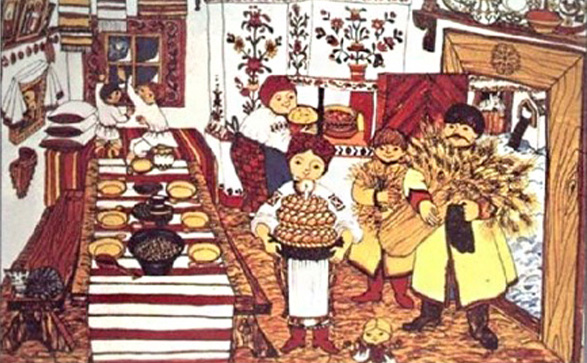
Here is how the ritual of Didukh introduction is described by Ukrainian ethnologist Stepan Kylymnyk in his book ‘Український рік у народних звичаях в історичному освітленні’ (‘Calendar Year in Ukrainian Folklore’), published in 1955. ‘The father and the son come into klunia (the storehouse for processing and curing sheaves, hay etc and keeping them), put off their hats and bow to Didukh-Rai.
The father takes the flower made of wheat spikes from his son’s hands and sprinkles Didukh. Bowing his head, he is telling while his son is repeating after him: ‘Dear Lord, and you, the righteous Sun, congratulate you with the Holly Christmas! Last year you gave us the harvest, the well-being, the wealth and the health ... Send us better and more this year!’ ‘Let’s take Didukh, my son, and bring the holidays into the house!’ The father comes first from the klunia: Didukh is in his right hand and a small bale of hay is under his left arm. Following his father, the son is carrying two bales of hay. Slowly and ceremoniously, they come to the house and stop before the corridor door. The mistress of the house is watching carefully from inside the house, takes knysh (bread), opens both the house door and the corridor door and meets the ‘guests’ with a slight bow. ‘Sviatky are coming!’, says the father.
‘Sviatky have come!’, says the boy.
‘Respect and ask Didukh and you to come into the house and farm’, answers the mistress carrying the knysh in her hands. There should be a candle burning on the table. On stepping over the threshold, the master says the greeting: ‘Be healthy, congratulations with the Holidays, with Didukh and Holly Christmas!’ The mistress takes the hay from under the arm of the master and spreads it in the pokuttia (the diagonal corner to the oven) and the master puts Didukh on it solemnly.
After that, the boy puts his first bale of hay on the table and the second one under the table. When Didukh is brought into the house, everybody is keeping silent. Establishing Didukh on the pokuttia, everyone is standing with their faces turned towards Didukh, while the master is telling, ‘You have filled, quenched the thirst and fed both us and our cattle, defended our fields and give us all these again this year!’
The image of the folk celebration calendar is also described by Oleksa Voropai. This Ukrainian ethnologist writes the following about Didukh’s entering the house. ‘The master brings a sheaf of rye, called ‘didukh’ into the house. Stepping over the threshold, he puts off his hat and greets the mistress as if he is the first time to enter the house. ‘Bless you the God for being healthy!’, says the master.
‘Let the God help you!’, answers the mistress. ‘What are you brining?’ ‘Gold, to live in wealth’, says the master stopping in the middle of the house. Now, he makes the saint sign of the cross and congratulates his family, ‘Congratulate you with happiness, health and these Holly Evening. In happiness and health spend these holidays and manage to meet the next one! From 100 summers to 100 years until Our Lord determines our age!’ On congratulating, the master brings ‘Didukh’ holding him high over the table and puts him in the pokuttia under the icons. Then the master tights ‘Didukh’ with iron chains and puts a yoke and handles from a plough. The mistress takes a new white table cloth from the trunk and covers all these, ‘To protect from the evil elements …’
Long ago, Didukh was put under the icons, but nowadays he is put in pokuttia on the feasting table, while the cookies are shaped as the agricultural equipment. It is thought that ‘Didukh-Rai’ or ‘Snip-Rai’ (sheaf) is the place where reside the spirits of grandfathers and great-grandfathers, guardians or patrons of the whole house. This is the explanation why such respect is given to Didukh who is not only the living place for grandparent spirits and the Harvest God, but also he symbolises the harvest of the next year, the well-being, the wealth and the destiny of the people. The ancestors believed that all good spirits together with the Harvest God come for the supper of Rich Kutia (special dish) – Holy Supper. That is why when the people are going to start the Holy Supper, they cover the benches and blow at the place where they are going to sit (in order not to sit on a spirit or a soul). A spare bowl and a spoon are laid for good spirits and those people of the family who are absent.
Didukh is the elder of the kin, the most respected symbol of the family. For the whole night, near Didukh, they put kolyvo (the commemoration dish with honey). Everything is arranged in such a way until the sheaf is in the house. Moreover, he is considered the protection and guard. It is said ‘Didukh comes into the house, any grief goes out of the house’. The straw or hay is respectively associated with woman. Under the table, under the table cloth and under the holiday kutia, the hay is laid to symbolise the manger where Jesus Christ was born.
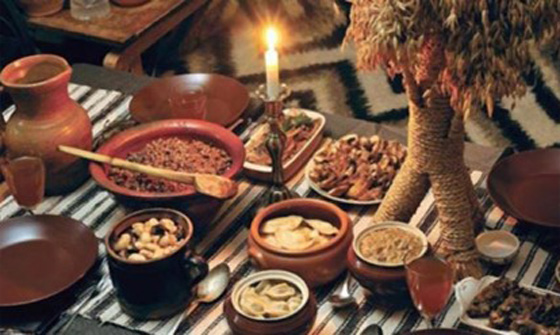
The extremely honorable celebration starts. Before the first star in the sky, nobody in the family eats any food, they are fasting. When the first star appears to declare the whole world on the great miracle – the Son of the God is born – the family put 12 lean dishes. 12 is the sacred number as there are 12 months in the year, there are 12 disciples chosen by Jesus Christ. Moreover, 12 dishes symbolise the results of the year. This lean supper is rich in variety of dishes and is the presentation of the principal crops of the field, garden and vegetable garden. It is as if the report to the next year on the riches of the passing year. Among the traditional dishes, one can find kutia, korovai or kalach (large round decorated bread), uzvar (a drink from dried fruits and berries), holubtsy (stuff stewed in cabbage rolls) with millet, peas, beans, mushrooms, buckwheat dish, varenyky (pierogi or dumplings) with strewed cabbage, those with potatoes, with cherries … . Kutia is the sacred dish for the Ukrainians, it has been the part of their culture for thousands of years. Kutia is on the table at the most significant events, assists to feel the connection of the generations. This dish can be prepared in varieties but there are main ingredients which are always put in it. They are wheat, honey, poppy seeds, nuts and dried fruits. Their integrity creates a balanced and delicious dish, full of symbols: wheat means life, honey – all its sweetness and happiness, nuts and dried fruits – well-being. Poppy seeds used to be thought as having magic properties and have a protective power against all the evil.
While the mistress of the house is working near the oven, the master is watering the cattle, laying new straw for them and giving the pleasant-smelting new hay. Then he clears the snow from the house, cleans all the paths to it and carefully inspects all in the farm. Everything, living and non-living, which the farm possesses, ought to meet the honorable hour of the Holly Evening and be at its place at this time. Nothing should be out of the house in other people’s hands as borrowed or forgotten. All the people of the family should be also at home. ‘God save us from spending this night out of the house. The whole year one who did it would be roaming the world in travels,’ the Ukrainians say. Heaven preserve us from quarrels on this day! On the contrary, it is good if you come to peace with your enemies for the sake of the happiness both within the house and out of it.
After sitting at the table, the father in the family gives a throw for kutia up to the ceiling. The family watches how many grains stuck to the ceiling. The more of them stick, the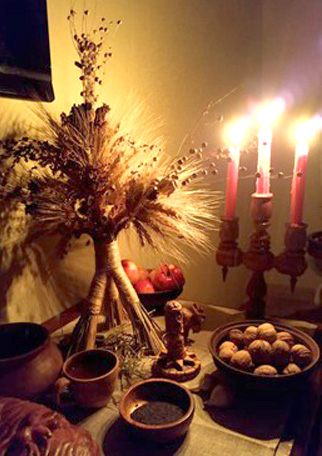 richer newborn is going to be the next year. After that each member of the family ought to eat three spoonfuls of kutia: for apiary, for newborn cattle, for hens giving newborns and rich grains. Every detail of the Holly Supper has its utmost importance. If the shadow on the wall resembles the stack of wheat, the grain harvest is going to be rich. If it looks like the haystack, there will be lots of hay next year. The tree-like shadow promises the good harvest in the garden… If a boy during the Holly Supper says that he is thirsty, the father would not allow him to drink. He would say, “Do not drink any water, my son, during the Holly Supper. You are of the Cossack blood. When you grow up, you will join a military campaign to earn the fame. During the troop movements, many things could be. There are times when there is no water to quench your thirst. So, know: if you can handle the thirst during the Holly Supper, you can withstand in the campaign!” Many other traditional talks are carried out at the feasting table before Didukh.
richer newborn is going to be the next year. After that each member of the family ought to eat three spoonfuls of kutia: for apiary, for newborn cattle, for hens giving newborns and rich grains. Every detail of the Holly Supper has its utmost importance. If the shadow on the wall resembles the stack of wheat, the grain harvest is going to be rich. If it looks like the haystack, there will be lots of hay next year. The tree-like shadow promises the good harvest in the garden… If a boy during the Holly Supper says that he is thirsty, the father would not allow him to drink. He would say, “Do not drink any water, my son, during the Holly Supper. You are of the Cossack blood. When you grow up, you will join a military campaign to earn the fame. During the troop movements, many things could be. There are times when there is no water to quench your thirst. So, know: if you can handle the thirst during the Holly Supper, you can withstand in the campaign!” Many other traditional talks are carried out at the feasting table before Didukh.
Didukh is playing his ritual role during the whole Christmas holiday period. He is within the house from the New Year to the Epiphany celebration (19 January) – not the same time period for various Ukrainian regions. Only after that he is threshed with a flail, his grains are mixed with others for sowing. His straw is traditionally burned on the road. In the western Ukraine, everyone who is able has to jump over that fire: elderly, young and children as this brings the health for the next year. Burning Didukh also means that it is high time for the souls of the dead to return to the heaven.
People say that the ashes from Didukh heal and cure the diseases which suffer both humans and animals. Wrapped Didukh ashes in a clean handkerchief are stored behind icons during the year time period or are dug under the trees for the good harvest. Such ashes could be cast on the hives for numerous bee families.
Nowadays, even the townsmen ought to sow the grain of Didukh even if this is done symbolically. You cannot throw Didukh into the garbage since he is an ancient cult symbol related not only to Christmas but also is the generation link, which should be continuous, the symbol of the wealth and well-being, the peace and life.
Didukh, the hay, and the Christmas traditions bear the positive energy and give us a sense of mystery and holidays. It is already a long tradition to install Didukh higher than 3-meters in his height on Christmas holidays on the central square in Lviv and other cities of Ukraine.
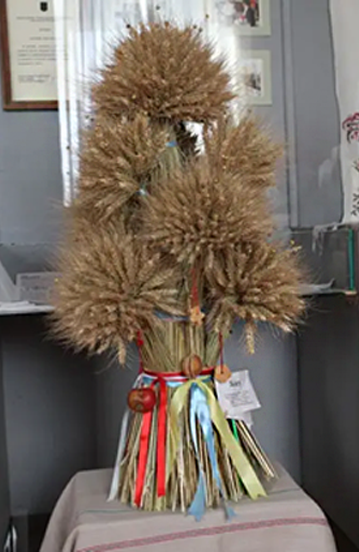
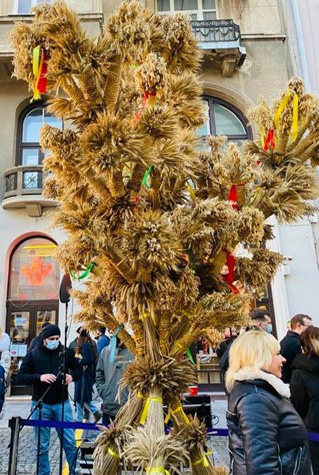
The good long traditions of Ukrainians are being revived in the contemporary families. We can take a pleasure of making the guard for the whole family and house, adding more peace and comfort to the Christmas time. Nowadays, the sheaf is substituted for a small bunch of spikes, various dry herbs and immortelle flowers. For the smallest Didukh bunch, you need at least 20 spikes. It is better to leave the spikes in hot water for 15 minutes for easy weaving. This makes spikes softer and elastic.
The full-scale Didukh might have three, five or seven legs and be made of unprocessed rye spikes, wheat or oats. Also this base is stuffed with medicinal herbs of light scent, being not only the decoration for Didukh but also making a practical use of him.
The spikes are to be ranged by sizes, 40 cm is the preferable length. The spikes are divided equally, seven in each sheaf. This means the seven days of the week. The sheaves are tightened with nice ribbons or threads of many colours. One of the versions is yellow and blue choice for making Didukh not only handsome but patriotic.
The readily made sheaves are bound to each other in a ladder way. The first row of this weaving is called the Future: there should be five sheaves in it. The next five sheaves are for the Present and the same number is taken for the Past. They are tied together 5 cm lower as well as the Future. Then they are tied to the Future in a way to arrange it as one having three legs. Each leg is shuttled between to places: near the base and below. The ‘legs’ are cut diagonally and parallel to the table and winded by the threads or left as spikes. So, the Christmas Defender is ready! Happy Christmas at every family table!
The real faith is in our hearts. It is true when we speak about the respect to the national traditions as old as hills and the profound Ukrainian spirituality. This is whence comes the Ukrainian symbol of Christmas – Didukh.
Tetiana Hloba
(this publication relies on the information from the DOUNB book collection and e-sources)
Our Advice to Read:
Воропай О. Звичаї нашого народу: етнографічний нарис.– Київ: Оберіг, 1993.– 590 с.
Килимник С. Український рік у народних звичаях в історичному освітленні: у 3 кн.– Кн. 1. (Зимовий цикл).– Київ: Обереги, 1994.– 400 c.
Скуратівський В.С. Дідух: свята українського народу.– Київ: Освіта, 1995.– 271 с.
Українські народні свята та звичаї / В.К. Сапіга.– Київ: Знання України.– 1993.– 112 с.
***
Майстер-клас із плетіння дідуха від Ганни та Василя Бутів. Запис 6.12.2020 р. на Оболоні; https://www.youtube.com/watch?v=-EFbzEuLkzQ
Солом’яний Дідух – символ Різдва в Україні: [Електронний ресурс].– Режим доступу: https://etnoxata.com.ua/statti/traditsiji/solomennyj-diduh-simvol-rozhdestva-na-ukraine/
Чому дідух є прадавнім символом Різдва в Україні і яким він є сьогодні: [Електронний ресурс].– Режим доступу: https://www.nta.ua/chomu-diduh-ye-pradavnim-symvolom-rizdva-v-ukrayini-i-yakym-vin-ye-sogodni/
Як швидко зробити головний символ Різдва – Дідух: [Електронний ресурс].– Режим доступу: https://ukranews.com/ua/news/470868-layfkhak-yak-shvydko-zrobyty-golovnyy-symvol-rizdva-didukh


